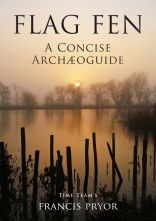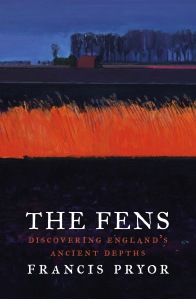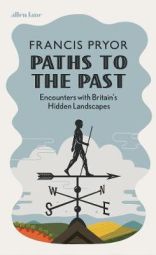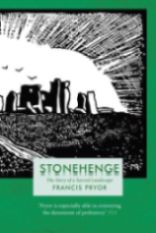
Flag Fen the day following its discovery in November 1982. Here David Gurney (now County Archaeologist of Norfolk) stands behind the spoil-heap left by the Anglian Water Board excavator that had just cleaned-out the dyke. At the top of the dykeside you can just make-out an orange layer, which was the make-up of a Roman Road (the Fen Causeway), built in AD 60. Maisie Taylor’s lower foot rests at the base of the Bronze Age buried soil, her left foot is at the base of the Bronze Age timber layer (still not yet visible in this picture). The water in the bottom of the dyke is at about half a metre below Sea Level (and we are 35 miles inland).
We discovered the extraordinary Bronze Age site at Flag Fen, Peterborough, exactly 30 years ago. To be honest I’m not certain of the precise date, but I think it was around the 3rd, or 4th of November, 1982. I’ve described that moment several times and I won’t repeat myself here, but you can read it in the ebook and in Flag Fen: Life and Death of a Prehistoric Landscape. But the point I want to make here, is that its discovery wasn’t an accident. It was part of a detailed survey of recently cleaned-out Fenland drainage dykes, which at the time (and with admirable originality) we called the Dyke Survey. That survey has been comprehensively written up by Charles French[1]; I had the idea of the survey and wrote a bit of the report, which is why my name (perhaps rather cheekily, in hindsight) appears on the title page. Incidentally, I’ve just heard that Charly has recently been honoured with the award of a Professorship at Cambridge. WELL DONE PROF CHARLY!!!
I had the idea of doing a dyke survey after I’d taken our team to Holland, where we collaborated in a big excavation at Assendelft[2], an early Iron Age project organized by the University of Amsterdam. To this day, I don’t know how I persuaded English Heritage to let me take the team abroad, but they did – and we had a wonderful time – and discovered Grolsch beer (which tasted very much better than the modern stuff with the same label, which is brewed in England). While we were at Amsterdam we were taught about Dutch-style dyke survey, which involved picking up artefacts along the edges of flooded dykes. They keep their fenlands very much wetter than we do. Anyhow, the principle was the same: to discover sites that are still buried and wet.

Bronze Age field boundary ditches, as excavated at Fengate in the summer of 1976. On the horizon are the chimneys of the Whittlesey brickworks. There’s a long hedge in the middle distance, in 1989 we discovered that this runs very approximately parallel to the Bronze Age post alignment, about a metre below it. The flag fen platform is less than half a mile from the excavations, in the direction of Whittlesey.
So we returned home and the following year started the dyke survey, in July, I think it was. Over the summer we made some remarkable finds, often of really old, Neolithic and Mesolithic sites, along the edges of buried ‘islands’. Then, in the autumn, we found Flag Fen and life, for me at least, hasn’t been the same since.
The 30th anniversary of Flag Fen was celebrated yesterday on Radio 4’s excellent Making History series, which also celebrates its 30th anniversary this month. At the end of a very good programme the two guest speakers, both distinguished academics made rather disparaging remarks about the Flag Fen crowd-funded excavations. I have to say, I thought their remarks verged on the haughty. Yes, we’d all love to open our excavations to everyone, and for free. Indeed, if I was receiving a large university grant, that’s precisely what I’d do. But the fact is, over the past thirty years, Flag Fen has received more than a million pounds of public money and I personally think there comes a time when one has to call a halt. After all, there are other worthy projects in England, that urgently need excavation and research. That’s one of the reasons it was decided to go down the crowd-funded route: as an experiment. And, happily, it was an experiment that worked: the participants had a good time, and the archaeology was professionally excavated, to a very high standard. The same will go for the report. So yes, it was funded by subscription, but the charges were very low and it’s far more important that somebody does something soon, because the site is rapidly drying-out and most of it won’t be there in thirty years’ time.
So get real, you academics. Climb out of your ivory towers and take a closer look at the modern world: you’ll discover it’s not all gloom and doom. There are a lot of good things going on out there, and (dare I say it?!) they’re not all as elitist as you…
[1] C.A.I. French and F.M.M. Pryor, The South-West Fen Dyke Survey Project 1982-86 East Anglian Archaeology, Report No. 59 (Fenland Archaeological Trust, Peterborough, 1993)
[2] L.L. Therkorn, R.W. Brandt, J.P. Pals and M. Taylor, ‘An early Iron Age farmstead: Site Q of the Assendelver Polders Project’, Proceedings of the Prehistoric Society, vol. 50, 1984, pp. 351-74















